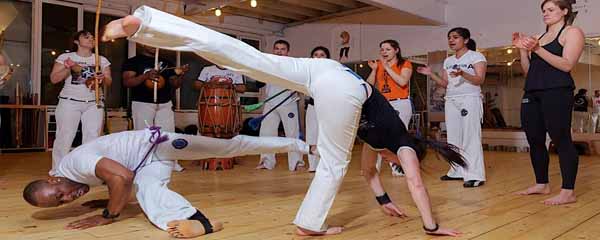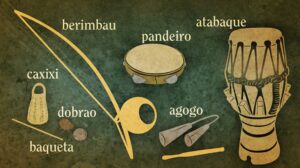Blog
Capoeira in Brazil – The Brazilian Martial Art: History & Techniques
- Wednesday August 2nd, 2023
- Posted by: Amanda Ennes
- Category: Brazil

Welcome to the captivating world of Capoeira in Brazil.
Capoeira is an enchanting Brazilian martial art that weaves mesmerizing movements, rhythmic music, and rich cultural heritage into a vibrant experience. In this blog article, we embark on a journey to unravel the fascinating history and unique techniques of Capoeira. Let’s trace its path from clandestine beginnings to becoming a revered global phenomenon. Join us as we explore the graceful acrobatics, soul-stirring rhythms, and profound camaraderie that define this extraordinary martial art. Discover the magic that makes Capoeira an art form like no other.
Do not forget: Caminhos offers free Capoeira lessons for its students every other week.
Table of Contents
ToggleWhat is Capoeira?
Capoeira is an Afro-Brazilian martial art that combines elements of music, dance, and acrobatics. It is comprised of specific offensive and defensive movements.
Additional reading: Brazilian Jiu-Jitsu- BJJ: History and Facts.
History of Capoeira in Brazil
The history of Capoeira traces back to the 16th century in Brazil, during colonial rule. Enslaved Africans brought to Brazil developed this martial art to resist oppression and preserve their identity.
Capoeira’s clandestine beginnings were necessary as slave owners forbade self-defense. Thus, to hide their training, the enslaved Africans disguised Capoeira as a dance accompanied by music, creating a clever tactic that allowed them to practice and pass down their traditions secretly.
Over time, Capoeira evolved into a symbol of freedom and unity, a testament to its creators’ resilience.
Read more: 6 Incredible Sports Invented in Brazil.
Musical Instruments
 In Capoeira, music plays a pivotal role, infusing the art form with energy, rhythm, and emotion. Several traditional musical instruments come together to create the mesmerizing sounds that accompany the Roda and its movements. Let’s check some of the most popular instruments used for Capoeira in Brazil:
In Capoeira, music plays a pivotal role, infusing the art form with energy, rhythm, and emotion. Several traditional musical instruments come together to create the mesmerizing sounds that accompany the Roda and its movements. Let’s check some of the most popular instruments used for Capoeira in Brazil:
- Berimbau: A single-stringed bow instrument called berimbau takes center stage, dictating the pace and style of the game. Its melody guide Capoeiristas’ (a practitioner of capoeira) movements. The berimbau indicates when to play more defensively or seize an opportunity to attack.
- Pandeiro: A tambourine-like drum that adds vibrant beats and cheerful rhythms.
- Atabaque: A larger drum that provides a deep and resonant tone.
- Agogô: A double bell that adds a distinct metallic sound to the mix.
The music undoubtedly plays an important role in Capoeira, as it is responsible for the rhythm of the practitioners. However, when people do not have these musical instruments with them, they use their hands to clap at the pace of Capoeira songs.
Ginga
At the heart of Capoeira lies the rhythmic and dynamic movement known as “ginga.” Often referred to as the fundamental soul of the art, ginga is a continuous swaying motion that embodies grace and agility. Moreover, Capoeiristas use ginga as their starting stance, constantly shifting their weight from one foot to the other in a seamless dance-like manner. This fluid movement not only showcases the art’s versatility but also symbolizes the essence of harmony and camaraderie in the roda.
Roda de Capoeira
“Roda de Capoeira” is the heart and soul of this captivating martial art, embodying its essence and spirit. Translating to “circle of Capoeira,” the Roda is a sacred space where practitioners come together to engage in a harmonious exchange of movements, music, and camaraderie. Forming a circle, with musicians sitting at its edge, participants take turns entering the center to showcase their skills. “Roda de Capoeira” is a celebration of diversity and creativity, as each Capoeirista expresses their unique style through fluid acrobatics, rhythmic kicks, and evasive maneuvers. The music, played on traditional instruments like the berimbau and pandeiro, infuses the Roda with energy and sets the pace of the game. In this mesmerizing dance of combat and artistry, the Roda de Capoeira embodies the rich cultural heritage and indomitable spirit of its originators, captivating the hearts of all who witness its enchanting rhythms.
Watch some of Caminhos free Capoeira lessons on our Instagram.
Techniques
Capoeira is renowned for its diverse array of techniques that blend martial arts, dance, and acrobatics into a captivating display of skill and creativity. Among the most popular techniques are:
- Au: A cartwheel-like move used for evasion and transitioning between positions.
- Martelo: A powerful spinning kick delivered from a handstand position.
- Meia Lua de Frente: A sweeping crescent kick executed while stepping forward.
- Bananeira: The handstand; showcases balance and core strength.
- Queixada: A strong spinning kick delivered in a circular motion.
- Armada: A spinning hook kick aimed at the upper body or head.
These techniques, among many others, exemplify the grace and agility inherent in Capoeira, allowing practitioners to express their individual style while engaging in the spirited rhythm of the road.
Styles of Capoeira in Brazil
Capoeira Angola
Capoeira Angola is a traditional style of Capoeira that preserves the art form’s historical roots and cultural significance. Known for its deliberate, fluid movements and close proximity to the ground, Capoeira Angola emphasizes deception and strategy over acrobatics. The gameplay is characterized by slow, rhythmic movements and storytelling elements, as practitioners engage in a dialogue of feints, dodges, and takedowns.
Capoeira Regional
Capoeira Regional, developed by Mestre Bimba in the early 20th century, is a more modern and dynamic style of Capoeira. This style introduced systematic training methods and structured movements, incorporating acrobatics, kicks, and fast-paced sequences into its gameplay. Characterized by its energetic and agile movements, Capoeira Regional places a strong emphasis on physical conditioning and self-defense techniques.
Capoeira in Modern Times
Nowadays, Capoeira has transcended its humble beginnings to become a globally recognized and celebrated martial art. What was once clandestine and confined to the streets of Brazil is now embraced by enthusiasts across continents. Capoeira schools and academies have sprouted worldwide, welcoming practitioners of all ages and backgrounds. Moreover, its unique blend of physicality, artistry, and cultural significance has captivated people. This means Capoeira is also a popular choice for fitness, self-expression, and social connection. Furthermore, nowadays Capoeira events, workshops, and competitions draw participants and spectators alike, fostering an international community that cherishes its traditions while embracing contemporary innovations. With its global recognition comes a responsibility to preserve the authenticity and historical roots of Capoeira, ensuring that this cherished art form continues to inspire generations to come.
Brazil recognizes “Roda de Capoeira” as a Brazilian Cultural Heritage. Furthermore, as of 2014, Unesco recognizes Capoeira as an Intangible Heritage of Humanity.
Capoeira Vocabulary
| Portuguese | Meaning |
|---|---|
| Capoeira | Brazilian martial art |
| Capoeirista | Capoeira practitioner |
| Roda de Capoeira | The circle where Capoeira is played |
| Ginga | a swaying movement in Capoeira, the base for all other movements |
| Mestre/Mestra | Capoeira instructor |
| Abadá | Capoeira uniform |
| Batizado | Ceremony when the Capoeira practitioner officially plays inside “Roda de Capoeira” for the first time |
| Jogo | Movements that two Capoeira practitioners do, attacking, defending, and counterattacking, within a rhythm |
Caminhos Language Centre is the largest and most exciting Portuguese school in Rio de Janeiro, Brazil. We have an excellent infrastructure, over 15 experienced Brazilian teachers, and a friendly multilingual support staff. We are the only school in Brazil able to offer Portuguese group courses throughout the year on 10 different levels. Moreover, our school also offers more than just Portuguese lessons for foreigners, we offer you the complete Rio de Janeiro experience. Every day we organize 100% free and fun activities for you to socialize and practice your Portuguese. We can also help you with a student visa for Brazil and accommodation in Rio de Janeiro. Follow us on Instagram for some Portuguese tips and news.


 Deutsch
Deutsch Français
Français Português
Português Español
Español

I love your texts, Amanda. Congrats!
Thank you so much!
They are really informative, enjoyable and well-written!